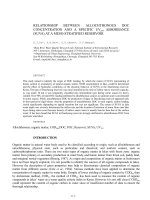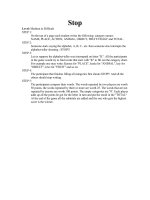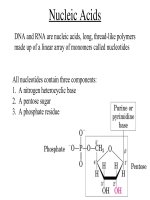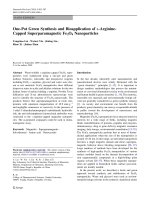One stop doc gastrolentrology and renal medicine
Bạn đang xem bản rút gọn của tài liệu. Xem và tải ngay bản đầy đủ của tài liệu tại đây (2.43 MB, 168 trang )
ONE STOP DOC
Gastroenterology
and Renal Medicine
One Stop Doc
Titles in the series include:
Cardiovascular System – Jonathan Aron
Editorial Advisor – Jeremy Ward
Cell and Molecular Biology – Desikan Rangarajan and David Shaw
Editorial Advisor – Barbara Moreland
Endocrine and Reproductive Systems – Caroline Jewels and Alexandra Tillett
Editorial Advisor – Stuart Milligan
Gastrointestinal System – Miruna Canagaratnam
Editorial Advisor – Richard Naftalin
Musculoskeletal System – Bassel Zebian and Wayne Lam
Editorial Advisor – Alistair Hunter
Nervous System – Elliott Smock
Editorial Advisor – Clive Coen
Nutrition and Metabolism – Miruna Canagaratnam and David Shaw
Editorial Advisors – Barbara Moreland and Richard Naftalin
Respiratory System – Jo Dartnell and Michelle Ramsay
Editorial Advisor – John Rees
Renal and Urinary System and Electrolyte Balance – Panos Stamoulos and Spyridon Bakalis
Editorial Advisors – Alistair Hunter and Richard Naftalin
Statistics and Epidemiology – Emily Ferenczi and Nina Muirhead
Editorial Advisor – Lucy Carpenter
Immunology – Stephen Boag and Amy Sadler
Editorial Advisor – John Stewart
Cardiology – Rishi Aggarwal, Emily Ferenczi and Nina Muirhead
Editorial Advisor – Darrel Francis
Volume Editor – Basant Puri
ONE STOP DOC
Gastroenterology
and Renal Medicine
Reena Popat MB BS BSc(Hons)
Senior House Officer in Medicine, Hammersmith Hospital, London, UK
Danielle Adebayo MB BS BSc(Hons)
Senior House Officer in Medicine, Hammersmith Hospital, London, UK
Contributing Author: Thomas Chapman MB BS BSc(Hons)
Foundation Year 1, Guy’s and St Thomas’ NHS Trust, London, UK
Editorial Advisor: Stephen Pereira BSc(Hons) PhD FRCP
Senior Lecturer in Hepatology & Gastroenterology, The UCL Institute of Hepatology, London, UK
Volume Editor: Basant Puri MA PhD MB BChir BSc(Hons) MathSci MRCPsych DipStat MMath
Professor and Consultant in Imaging and Psychiatry and Head of the Lipid Neuroscience Group,
Hammersmith Hospital, London, UK
Series Editor: Elliott Smock MB BS BSc(Hons)
Senior House Officer (FY2), University Hospital Lewisham, Lewisham, UK
A MEMBER OF THE HODDER HEADLINE GROUP
First published in Great Britain in 2007 by
Hodder Arnold, an imprint of Hodder Education and a member of the Hodder Headline Group,
an Hachette Livre UK Company, 338 Euston Road, London NW1 3BH
© 2007 Edward Arnold (Publishers) Ltd
All rights reserved. Apart from any use permitted under UK copyright law,
this publication may only be reproduced, stored or transmitted, in any form,
or by any means with prior permission in writing of the publishers or in the
case of reprographic production in accordance with the terms of licences
issued by the Copyright Licensing Agency. In the United Kingdom such
licences are issued by the Copyright Licensing Agency: Saffron House,
6–10 Kirby Street, London EC1N 8TS.
Whilst the advice and information in this book are believed to be true and
accurate at the date of going to press, neither the authors nor the publisher
can accept any legal responsibility or liability for any errors or omissions
that may be made. In particular, (but without limiting the generality of the
preceding disclaimer) every effort has been made to check drug dosages;
however it is still possible that errors have been missed. Furthermore,
dosage schedules are constantly being revised and new side-effects
recognized. For these reasons the reader is strongly urged to consult the
drug companies’ printed instructions before administering any of the drugs
recommended in this book.
Hodder Headline’s policy is to use papers that are natural, renewable and
recyclable products and made from wood grown in sustainable forests.
The logging and manufacturing processes are expected to conform to the
environmental regulations of the country of origin.
British Library Cataloguing in Publication Data
A catalogue record for this book is available from the British Library
Library of Congress Cataloging-in-Publication Data
A catalog record for this book is available from the Library of Congress
ISBN 978 0340 92556 0
1 2 3 4 5 6 7 8 9 10
Commissioning Editor: Sara Purdy
Project Editor:
Jane Tod
Production Controller: Lindsay Smith
Cover Design:
Amina Dudhia
Indexer:
Indexing Specialists (UK) Ltd
Typeset in 10/12pt Adobe Garamond/Akzidenz GroteskBE by Servis Filmsetting Ltd, Manchester
Printed and bound in Spain
What do you think about this book? Or any other Hodder Arnold title?
Please visit our website at www.hoddereducation.com
CONTENTS
PREFACE
vi
ABBREVIATIONS
vii
SECTION 1
RENAL MEDICINE
1
SECTION 2
HEPATOBILIARY MEDICINE
43
SECTION 3
UPPER GASTROINTESTINAL MEDICINE
81
SECTION 4
LOWER GASTROINTESTINAL MEDICINE
117
APPENDIX
151
INDEX
153
PREFACE
From the Series Editor, Elliott Smock
Are you ready to face your looming exams? If you
have done loads of work, then congratulations; we
hope this opportunity to practise SAQs, EMQs,
MCQs and Problem-based Questions on every part
of the core curriculum will help you consolidate what
you’ve learnt and improve your exam technique. If
you don’t feel ready, don’t panic – the One Stop Doc
series has all the answers you need to catch up and
pass.
There are only a limited number of questions an
examiner can throw at a beleaguered student and this
text can turn that to your advantage. By getting
straight into the heart of the core questions that come
up year after year and by giving you the model
answers you need this book will arm you with the
knowledge to succeed in your exams. Broken down
into logical sections, you can learn all the important
facts you need to pass without having to wade
through tons of different textbooks when you simply
don’t have the time. All questions presented here are
‘core’; those of the highest importance have been
highlighted to allow even shaper focus if time for
revision is running out. In addition, to allow you to
organize your revision efficiently, questions have been
grouped by topic, with answers supported by detailed
integrated explanations.
On behalf of all the One Stop Doc authors I wish
you the very best of luck in your exams and hope
these books serve you well!
From the Authors, Reena Popat and
Danielle Adebayo
This book is intended primarily for clinical medical
students preparing for exams in renal medicine and
gastroenterology, but will also be useful for junior
doctors who are revising. It is not meant to be a textbook of medicine, but highlights key areas often
focused on during the exams and in day-to-day clinical practice. We have tried to distil the core topics in
this specialty. The questions at the beginning of each
topic should help hone in the essential points.
We hope that this book also helps you work through
clinical scenarios in a systematic manner, and to
develop differential diagnoses and a competent management plan both as clinical students and junior
doctors.
ABBREVIATIONS
AAT
ACE
ACTH
ADH
AFB
AFP
Ag
AJCC TNM
ALF
ALP
ALT
AMA
ANA
ANCA
APACHE
ARDS
ARF
ASO
AST
ATN
ATP
BDG
BE
BM
BMG
BP
CEA
CLF
CMV
CNS
CO
COPD
CRF
CRP
Cr
CRF
CT
CVA
␣1-antitrypsin
angiotensin-converting enzyme
adrenocorticotrophic hormone
antidiuretic hormone
acid-fast bacilli
␣-fetoprotein
antigen
American Joint Committee on Cancer,
Tumor, Node and Metastases
acute liver failure
alkaline phosphatase
alanine transaminase
antimitochondrial antibody
antinuclear antibody
antineutrophil cytoplasmic antibody
Acute Physiology And Chronic Health
Evaluation
acute respiratory distress syndrome
acute renal failure
antistreptolysin O
aspartate transaminase
acute tubular necrosis
adenosine triphosphate
bilirubin diglucuronide
base excess
blood sugar
bilirubin monoglucuronide
blood pressure
carcinoembryonic antigen
chronic liver failure
cytomegalovirus
central nervous system
cardiac output
chronic obstructive pulmonary disease
chronic renal failure
C-reactive protein
creatinine
chronic renal failure
computed tomography
cerebrovascular accident
CVP
DIC
DMSA
DNA
dsDNA
EBV
ECF
ECG
ESR
ESRF
ERCP
FAP
FBC
FIO2
FSGS
GBM
GCS
GI
GFR
GGT
GORD
GP
Hb
HB
HCC
HDU
5-HIAA
HIV
HLA
HMG CoA
HNPCC
HR
HSP
5-HT
HUS
IBD
IBS
Ig
central venous pressure
disseminated intravascular coagulation
dimercaptosuccinic acid
deoxyribonucleic acid
double-stranded deoxyribonucleic acid
Epstein–Barr virus
extracellular fluid
electrocardiogram
erythrocyte sedimentation rate
end-stage renal failure
endoscopic retrograde
cholangiopancreatography
familial adenomatous polyposis
full blood count
fraction of inspired oxygen
focal segmental glomerulosclerosis
glomerular basement membrane
Glasgow coma scale
gastrointestinal
glomerular filtration rate
␥-glutamyl transferase
gastro-oesophageal reflux disease
general practitioner
haemoglobin
hepatitis B
hepatocellular carcinoma
high-dependency unit
5-hydroxy indole-acetic acid
human immunodeficiency virus
human leucocyte antigen
5-hydroxy-3-methylglutarylcoenzyme A
hereditary non-polyposis colon cancer
heart rate
Henoch–Schönlein purpura
5-hydroxytryptamine
haemolytic uraemic syndrome
inflammatory bowel disease
irritable bowel syndrome
immunoglobulin
viii
ITU
IV
JVP
KUB
LDH
LMP
LOS
MALT
MC&S
MEN
MIBG
MRA
MRCP
MRI
MSU
NG
NSAID
OGD
PaCO2
PaO2
PAS
PBC
PET
PPI
PSC
PTC
ABBREVIATIONS
intensive therapy unit
intravenous
jugular venous pressure
kidneys, ureters and bladder
lactate dehydrogenase
last menstrual period
lower oesophageal sphincter
mucosa-associated lymphoid tissue
microscopy, culture and sensitivity
multiple endocrine neoplasia
131iodine-meta-iodobenzylguanidine
magnetic resonance angiogram
magnetic resonance
cholangiopancreatography
magnetic resonance imaging
midstream urine
nasogastric tube
non-steroidal anti-inflammatory drug
oesophago-gastroduodenoscopy
partial pressure of arterial carbon
dioxide
partial pressure of arterial oxygen
periodic acid–Schiff
primary biliary cirrhosis
positron emission tomography
proton pump inhibitor
primary sclerosing cholangitis
percutaneous transhepatic
cholangiography
PVR
RBC
RF
RNA
RUQ
sBP
SCC
SIADH
SLE
TB
TBW
TCC
TENS
TIPS
TNM
TPN
TURP
UDP
UGT
UTI
VIP
WCC
WHO
peripheral vascular resistance
red blood cell
renal failure
ribonucleic acid
right upper quadrant
systolic blood pressure
squamous cell carcinoma
syndrome of inappropriate ADH
secretion
systemic lupus erythematosus
tuberculosis
total body water
transitional cell carcinoma
transcutaneous electrical nerve
stimulation
transjugular intrahepatic portosystemic
shunt
tumour, node, metastasis
total parenteral nutrition
trans-urethral resection of the prostate
uridine diphosphate
UDP glucuronyl transferase
urinary tract infection
vasoactive intestinal peptide
white cell count
World Health Organization
SECTION
1
RENAL MEDICINE
• FLUID AND ELECTROLYTE BALANCE
2
• SODIUM BALANCE
4
• POTASSIUM BALANCE
8
• ACID–BASE BALANCE
10
• ACUTE RENAL FAILURE
14
• CHRONIC RENAL FAILURE
18
• GLOMERULONEPHRITIS
22
• HAEMATURIA
26
• RENOVASCULAR DISEASE AND
HYPERTENSION
30
• PROTEINURIA AND NEPHROTIC SYNDROME
32
• RENAL ONCOLOGY (I)
34
• RENAL ONCOLOGY (II)
36
• URINARY TRACT INFECTION (I)
38, 41
• URINARY TRACT INFECTION (II)
40, 42
SECTION
1
RENAL MEDICINE
1. For the following scenarios choose the most appropriate fluid replacement. Each option
may be used once only
Options
A.
B.
C.
D.
E.
Normal saline
Dextrose saline
Normal saline ϩ 20 mmol KCl
Normal saline ϩ 80 mmol KCl
Albumin
F.
G.
H.
I.
J.
Blood
Gelofusin
5 per cent dextrose
Hartmann’s solution
1.26 per cent sodium bicarbonate
1. A 73-year-old patient with confusion, a pulsatile abdominal mass, heart rate of 144 bpm,
blood pressure of 84/56 mmHg and anuria
2. A 35-year-old patient presenting with vomiting and diarrhoea, tachycardia and postural
hypotension
3. A 20-year-old patient with the first presentation of type 1 diabetes mellitus presenting with
diabetic ketoacidosis on an insulin sliding scale and a blood sugar (BM) of 7.8 mmol/L
4. A 78-year-old woman with confusion, plasma Naϩ of 168 mmol/L and Kϩ of 4.2 mmol/L
5. A 40-year-old patient admitted with pyelonephritis, now has oliguria and reduced CVP
2. Typical fluid volumes in a 70 kg man are
Options
A. 42 L
B. 60 L
C. 3.5 L
1.
2.
3.
4.
5.
D. 7.5 L
E. 18 L
F. 28 L
G. 10.5 L
H. 5.5 L
I. 14 L
J. 25 L
Total body water
Intracellular
Extracellular
Interstitial
Intravascular
3. When assessing a patient’s hydration status, the following are signs of mild dehydration
a. Oliguria
b. Reduced skin turgor
c. Confusion
d. Compromised cardiovascular status
e. Dry mucous membranes
BM, blood sugar; CVP, central venous pressure; ECF, extracellular fluid
Renal medicine
3
EXPLANATION: FLUID AND ELECTROLYTE BALANCE
The nephron and extra-renal mechanisms play a vital role in body fluid and electrolyte homeostasis. The fluid
compartments in a 70 kg man can be demonstrated as below:
Intracellular: 40% body
weight, 28 L (K+ rich)
Interstitial fluid: 15% body
weight, 10.5 L
Total body water: 60%
body weight, 42 L
Extracellular: 20% body
weight, 14 L (Na+ rich)
Intravascular: 5% body
weight, 3.5 L
Water moves freely between these compartments with changes in osmolality. The principal cation in the extracellular fluid (ECF) is Naϩ , which is the major indicator of plasma osmolality.
Plasma osmolality ϭ 2{[Naϩ ]ϩ[Kϩ ]}ϩblood [glucose]ϩblood [urea]
FLUID LOSS
• Sensible: renal ϭ 1500 mL ϩ gastrointestinal ϭ 100 mL
• Insensible: skin ϭ 500 mL ϩ respiratory ϭ 400 mL.
FLUID INTAKE
Ingested ϭ 2100 mL ϩ metabolic ϭ 400 mL.
Adults require 30–35 mL/kg/day of water, 2 mmol/kg/day Naϩ and 0.5–1 mmol/kg/day Kϩ for maintenance of
normal fluid and electrolyte balance. Abnormal losses of fluids and electrolytes can be secondary to vomiting, diarrhoea, the polyuric phase of renal failure and burns. Fluids administered in the clinical setting can be divided into:
• Crystalloids: it is important to know the major constituents of crystalloids administered on the wards:
Solution
Na؉
(mmol/L)
Cl؊
(mmol/L)
K؉
(mmol/L)
Other
(mmol/L)
Osmolality
(mosmol/L)
Normal saline
0.45% saline
5% dextrose
Hartmann’s solution
Dextrose saline
154
77
–
131
31
154
77
–
112
31
–
–
–
5
–
–
–
–
HCO3– 29, Ca2ϩ 4
–
308
154
278
281
284
It is safe to administer Kϩ when the urine output is Ͼ40 mL/h. It should not be administered faster than
40 mmol/h, and no greater than 40 mmol of Kϩ should be added to a 1 L fluid bag.
• Colloids such as gelofusin, human albumin solution, human plasma protein fraction and dextran.
• Blood and blood products.
When assessing a patient’s hydration status, a thorough history, examination and a fluid balance chart of input
and output is essential. Mild dehydration (Ͻ4 per cent body weight loss) is characterized by thirst, reduced
skin turgor, sunken eyes and dry mucous membranes. Features of moderate dehydration (4–8 per cent body
weight loss) include oliguria, orthostatic hypotension, tachycardia and reduced CVP (normal 3–8 cmH2O).
Patients with severe dehydration (8–10 per cent body weight loss) present with profound oliguria, a compromised cardiovascular status and confusion.
Answers
1. 1 – F, 2 – C, 3 – H, 4 – A, 5 – G
2. 1 – A, 2 – F, 3 – I, 4 – G, 5 – C
3. F T F F T
ONE STOP DOC
4
4. You are the admitting doctor in the emergency department. An 84-year-old woman is
brought by ambulance, having been found collapsed at home. She presents with oliguria,
dry mucous membranes, confusion and convulsions
a. The patient’s blood results come back from the laboratory, and the serum sodium is
165 mmol/L. What is the normal range of plasma [Naϩ ]?
b. What are the possible causes of this patient’s hypernatraemia? What is the most likely
cause in this case?
c. How would you manage this patient initially?
d. Describe how you would investigate this patient
5. Possible investigations for hypernatraemia include
a.
b.
c.
d.
e.
Blood glucose levels
Urea and creatinine levels
Blood cortisol levels
Spinal MRI
Added water deprivation test
BP, blood pressure; Cr, creatinine; CT, computed tomography; IV, intravenous; MRI, magnetic resonance imaging
Renal medicine
5
EXPLANATION: SODIUM BALANCE
The normal range of plasma [Naϩ ] is 135–145 mmol/L (4a). Refer to the Appendix, page 151 for the physiological mechanisms controling Naϩ homeostasis.
HYPERNATRAEMIA ([Na؉ ] Ͼ150 mmol/L)
The patient can present with pyrexia, nausea and vomiting, signs and symptoms of dehydration, convulsions,
focal neurology and coma.
Causes are identified below (4b):
Extra-renal
Renal
Pure water depletion
Failure of water intake (elderly, post-operatively)
Fever
Hyperventilation
Adipsia (anterior communicating artery aneurysm,
intra-hypothalamic or pituitary haemorrhage,
neoplasm, granuloma)
Diabetes insipidus
Chronic renal failure
Hypotonic fluid loss
Diarrhoea
Vomiting
Excessive sweating
Osmotic diuresis, e.g.
diabetes mellitus, excess urea
Mannitol use
Salt gain
Iatrogenic (IV fluids, antibiotics in Naϩ salt solutions)
Cushing’s syndrome
Conn’s syndrome (↑BP, ↑Kϩ , ↑HCO3–)
Possible investigations include (4d):
• Urine osmolality and [Naϩ ]. Added water deprivation test:
• high urine output and osmolality – osmotic diuresis
• urine osmolality Ͻ plasma osmolality – suggests diabetes insipidus
• Blood glucose, renal profile ([Naϩ ], [Kϩ ], urea and Cr levels)
• Blood cortisol levels
• Head CT/MRI to exclude a pituitary tumour.
The rehydration must be gradual over 48 to 72 h (4c) to prevent the risk of cerebral oedema. The fluid
of choice is often normal saline (relatively hypotonic in hypernatraemia). Correct [Naϩ ] at a rate of
Ͻ0.5 mmol/L/h. The underlying cause should also be addressed.
Continued on page 7
Answers
4. See explanation. The most likely cause is dehydration
5. T T T F T
ONE STOP DOC
6
6. Causes of hyponatraemia include
a.
b.
c.
d.
e.
Diabetes insipidus
Addison’s disease
Hypothyroidism
Conn’s syndrome
Subarachnoid haemorrhage
7. Hyponatraemia may present with
a.
b.
c.
d.
e.
Pyrexia
Coma
Convulsions
Vomiting
Dehydration
ADH, antidiuretic hormone; IV, intravenous; SIADH, syndrome of inappropriate ADH secretion; TURP, trans-urethral resection of the prostate
Renal medicine
7
EXPLANATION: SODIUM BALANCE Cont’d from page 5
HYPONATRAEMIA ([Na؉ ] Ͻ130 mmol/L)
This is more common than hypernatraemia. The patient can present with nausea and vomiting, lethargy,
muscle weakness, confusion, ataxia, convulsions and coma.
Causes include:
Eutonic:
• Pseudohyponatraemia – hyperglycaemia, hyperlipidaemia
• Surgical irrigation fluids (TURP syndrome)
Hypotonic:
• Hypovolaemia:
• diuretic use
• Addison’s disease
• renal tubular acidosis
• diarrhoea
• vomiting
• subarachnoid haemorrhage
• Normovolaemia:
• SIADH
• iatrogenic: IV fluids; paracetamol and indometacin (potentiate ADH at collecting tubule); barbiturates,
opioids, carbamazepine and tricyclics (increase ADH secretion)
• hypothyroidism
• renal failure
• pseudohyponatraemia
• Hypervolaemia:
• congestive heart failure
• cirrhosis
• nephrotic syndrome.
Possible investigations include:
• Urine osmolality and [Naϩ ]. The latter will help differentiate renal from non-renal causes
• Blood glucose, renal profile, lipid profile, thyroid profile and cortisol level
• Imaging studies depending on the cause, for example, chest X-ray for heart failure.
Acute hyponatraemia (Ͻ48 h duration) with the presence of neurological symptoms should be corrected
quickly using hypertonic 3 per cent saline, which can be combined with loop diuretics to increase water excretion. Chronic hyponatraemia (Ͼ48 h duration) should be corrected gradually to prevent central pontine
myelinolysis. The underlying cause should be treated. Patients with hypervolaemic or normovolaemic hypotonic hyponatraemia may need to be fluid restricted and the underlying cause should be treated.
Answers
6. F T T F T
7. T T T T T
ONE STOP DOC
8
8. Regarding hyperkalaemia
a.
b.
c.
d.
e.
It can present with paralytic ileus
It is associated with acidosis
ECG changes include peaked T waves and narrowed QRS complexes
IV calcium gluconate is used to reduce blood Kϩ levels
ECG changes can progress to asystole if left untreated
9. ECG changes associated with hyperkalaemia include
a.
b.
c.
d.
e.
Tall peaked T waves
Shortened QT interval
Widened QRS complex
Widened P waves
Ventricular fibrillation
10. As the on-call junior doctor on Saturday night, you are called to see a 27-year-old
patient with chronic renal failure whose latest biochemistry results have demonstrated
a serum potassium of 7 mmol/L. You note that his last venesection was performed by
an inexperienced phlebotomist using a needle and syringe
a. What is the normal range of plasma [Kϩ ]?
b. Describe the common causes of hyperkalaemia. What are two possible causes of this
patient’s biochemistry result?
c. You take an arterial blood gas sample that provides an instant serum potassium level of
7.2 mmol/L. What is this patient at risk of?
d. How would you manage this patient initially?
11. Regarding hypokalaemia
a.
b.
c.
d.
e.
ECG changes include ST segment elevation and a widened QRS complex
It can present with generalized muscle weakness
It is most commonly the result of insufficient dietary intake
It can occur as part of refeeding syndrome
It may be associated with hypomagnesaemia
ECG, electrocardiogram; GI, gastrointestinal; IV, intravenous
Renal medicine
9
EXPLANATION: POTASSIUM BALANCE
The normal range of plasma [Kϩ ] is 3.5–5 mmol/L (10a).
Tall peaked T waves
HYPERKALAEMIA ([K؉ ] Ͼ5 mmol/L)
The clinical features of hyperkalaemia include:
• Muscle weakness
• ECG changes (see figure opposite): tall peaked T waves, shortened QT interval, widened QRS complex, widening and eventually loss of P waves, sine wave pattern, ventricular fibrillation.
Widened
Aetiology is as follows (10b):
QRS complex
• Pseudohyperkalaemia: prolonged tourniquet use, in vitro
haemolysis, delayed transfer of sample for analysis and hyperventilation
• Excessive intake: blood transfusion and excessive IV infusion
• Impaired excretion: renal failure, Addison’s disease and drugs such as Kϩ -sparing diuretics
• Tissue redistribution: trauma, burns, rhabdomyolysis, tumour lysis syndrome, haemolysis and acidosis.
[Kϩ ]Ͼ6.5 mmol/L is an emergency and requires prompt treatment as it can lead to sudden death from cardiac
arrhythmias (10c).
EMERGENCY MANAGEMENT OF HYPERKALAEMIA (10d):
Immediate:
• To protect myocardium: 10 mL 10 per cent calcium gluconate IV if ECG changes (may be repeated every
10 min until ECG normalizes)
• To lower serum potassium: insulin (Actrapid 10 units) and 50 mL 20 per cent dextrose IV; nebulized
salbutamol (5–10 mg) to drive Kϩ intracellularly.
Longer term:
• To deplete body Kϩ : polysterene sulphonate resins – 30 g enema; 15 g orally three times daily.
Consider need for dialysis.
HYPOKALAEMIA ([K؉ ] Ͻ3.5 mmol/L)
The clinical features of hypokalaemia include:
• Anorexia, nausea, muscle weakness, paralytic ileus
• ECG changes (see figure opposite): small or inverted T waves, increased
height of U wave, ST segment depression, widened QRS complex.
U wave
Aetiology is as follows:
• Increased GI loss: diarrhoea, vomiting, fistulae, villous adenoma, refeeding syndrome and laxatives
• Increased renal loss: diuretics, hyperaldosteronism, renal artery stenosis and osmotic diuresis
• Tissue redistribution: insulin therapy, alkalosis and catecholamines
• Reduced intake (rare).
Hypokalaemia can be associated with hypomagnesaemia, therefore magnesium deficiency must be sought and
corrected first.
Answers
8.
9.
10.
11.
FTFFT
TTTTT
See explanation
FTFTT
ONE STOP DOC
10
12. Concerning metabolic acidosis
a.
b.
c.
d.
e.
The pH of plasma is increased
Causes can be differentiated by calculating the anion gap
If chronic, it leads to an increase in the PaCO2
It can result after severe haemorrhage
Salicylate poisoning always results in metabolic acidosis
13. A 30-year-old patient presents with pH 7.2, PaCO2 3.0 kPa, base excess –7, HCO3–
17 mmol/L, Naϩ 136 mmol/L, Kϩ 4.2 mmol/L, Cl– 108 mmol/L. The possible causes
of this picture include
a. Ileostomy
b. Diabetic ketoacidosis
c. Renal tubular acidosis
d. Methanol ingestion
e. Uraemia
BE, base excess; HMG CoA, 5-hydroxy-3-methylglutaryl-coenzyme A; PaCO2, partial pressure of arterial carbon dioxide; PaO2, partial pressure
of arterial oxygen; TPN, total parenteral nutrition
Renal medicine
11
EXPLANATION: ACID–BASE BALANCE
Acid–base disturbances are commonly associated with renal impairment. However, they may also follow respiratory pathologies. Differentiation between metabolic and respiratory disturbances can be determined by
measuring the parameters of acid–base status.
Normal acid–base values are as follows:
• pH 7.35–7.45
• Pao2 10.5–14 kPa
• Paco2 4.5–6 kPa
• HCO3– 22–26 mmol/L
• BE Ϯ2 mmol/L.
Metabolic acidosis
Metabolic alkalosis
Respiratory acidosis
Respiratory alkalosis
pH
PaCO2
HCO3–
↓
↑
↓
↑
↔/↓
↔/↑
↑
↓
↓
↑
↔/↑
↔/↓
Causes of metabolic acidosis include:
• Normal anion gap (10Ϫ18 mmol/Lϭ([Naϩ ]ϩ[Kϩ ])Ϫ([Cl–]ϩ[HCO3–]); this signifies HCO3– loss):
• diarrhoea
• biliary/pancreatic fistulae
• ileostomy
• renal tubular acidosis
• Addison’s disease
• hyperalimentation (TPN)
• High anion gap (Ͼ18 mmol/L, suggests the presence of abnormal acid production):
• diabetic ketoacidosis
• lactic acidosis
• renal failure
• salicylate intoxication
• methanol or ethylene glycol ingestion
• paraldehyde poisoning
• inborn errors of metabolism, e.g. HMG CoA lyase deficiency.
Metabolic acidosis is often partially compensated for by hyperventilation (reduced Paco2).
The underlying cause should be treated. In life-threatening cases (pH Ͻ7.2), sodium bicarbonate can be
infused slowly.
Continued on page 13
Answers
12. F T F T F
13. T F T F F
ONE STOP DOC
12
14. Concerning respiratory acidosis
a.
b.
c.
d.
e.
It is associated with a bounding pulse
It can occur in patients with Guillain–Barré syndrome
It may result from opiate overdose
Renal retention of bicarbonate may occur in chronic cases
Treatment may include respiratory support
15. For the following blood gases choose the most appropriate diagnosis. Each option may
be used once only
Options
A.
B.
C.
D.
E.
Diarrhoea
Vomiting
Hyperventilation
Salicylate intoxication
Acute COPD exacerbation
F.
G.
I.
H.
J.
1.
2.
3.
4.
5.
pH 7.25, PaCO2 7.8 kPa, PaO2 8.5 kPa, HCO3– 25 mmol/L
pH 7.37, PaCO2 8.1 kPa, PaO2 7.8 kPa, HCO3– 35 mmol/L
pH 7.5, PaCO2 3 kPa, PaO2 13.5 kPa, HCO3– 24 mmol/L
pH 7.22, PaCO2 2.8 kPa, PaO2 11 kPa, HCO3– 18 mmol/L
pH 7.49, PaCO2 4.1 kPa, PaO2 11 kPa, HCO3– 30 mmol/L
COPD patient treated with 60 per cent O2
Chronic COPD
Altitude
Normal
Diabetic ketoacidosis
ARDS, acute respiratory distress syndrome; CNS, central nervous system; COPD, chronic obstructive pulmonary disease; CVA, cerebrovascular
accident; NG, nasogastric tube; PaCO2, partial pressure of arterial carbon dioxide; PaO2, partial pressure of arterial oxygen
Renal medicine
13
EXPLANATION: ACID–BASE BALANCE Cont’d from page 11
Causes of metabolic alkalosis include:
• Loss of acid:
• vomiting
• NG suction
• gastrocolic fistula
• hyperaldosteronism
• diuretic use
• Gain of HCO؊
3:
• sepsis
• exogenous alkali, e.g. antacid abuse
• over-treatment of acidosis.
Metabolic alkalosis is rarely partially compensated for by hypoventilation, as the associated reduction in PaO2
stimulates the respiratory centres. The underlying cause should be treated.
Causes of respiratory acidosis include:
• Respiratory depression: central causes such as CVA, drug overdose, e.g. opiates and late salicylate poisoning
• Muscular weakness: Guillain–Barré syndrome, myasthenia gravis, botulinum poisoning
• Infection: pneumonia
• Acute respiratory diseases: asthma, acute exacerbation of COPD.
Signs of CO2 retention may occur. These include bounding pulse, flap tremor and papilloedema.
Chronic cases of respiratory acidosis may be partially compensated for by renal retention of HCO3– (metabolic
alkalosis). Treatment involves management of the underlying cause, and may include ventilatory support.
Causes of respiratory alkalosis include:
• CNS lesions (CVA), neoplasm, infection
• Salicylate intoxication
• Septicaemia
• Anxiety
• High altitude
• Cirrhosis
• Pneumonia
• Pulmonary embolus
• ARDS
• Pulmonary oedema.
Chronic cases of respiratory alkalosis may be partially compensated for by increased renal excretion of HCO3–
(metabolic acidosis). The underlying cause should be addressed.
Answers
14. T T T T T
15. 1 – E, 2 – G, 3 – C, 4 – J, 5 – B
ONE STOP DOC
14
16. The following are causes of acute renal failure
a. Hypovolaemia
b. Sepsis
c. Polycystic kidney disease
d. Prostate disease
e. Renovascular disease
17. Acute renal failure is associated with
a. Anaemia
b. Hyperkalaemia
c. Hyperphosphataemia
d. Normal renal size
e. Polyuria
18. When considering acute tubular necrosis
a.
b.
c.
d.
e.
It most often results from renal ischaemia
Drugs commonly implicated include NSAIDs and aminoglycosides
It is always reversible on reperfusion of the kidney
The urine sodium is typically greater than 40 mmol/L
The urine osmolality is greater than in pre-renal causes of ARF
19. Draw a table differentiating the urinary findings in acute tubular necrosis and pre-renal
acute renal failure
ARF, acute renal failure; ATN, acute tubular necrosis; Cr, creatinine; GFR, glomerular filtration rate; GI, gastrointestinal; NSAID, non-steroidal
anti-inflammatory drug
Renal medicine
15
EXPLANATION: ACUTE RENAL FAILURE
Acute renal failure (ARF) is defined as a rapid decline in renal function over hours to days that leads to retention of nitrogenous waste products (urea and Cr) and impairment of the acid–base balance. It is usually characterized by oliguria (Ͻ400 mL/day), however, 10–15% of cases are non-oliguric. The glomerular filtration
rate (GFR) may fall by approximately 50 per cent before blood Cr levels rise, hence blood Cr is not a sensitive
measure of ARF.
PRE-RENAL CAUSES
• Hypovolaemia: haemorrhage, GI loss, third space loss (pancreatitis), renal loss (diabetes insipidus), skin and
mucous membrane losses (burns)
• Systemic hypotension: cardiogenic shock, sepsis and liver failure
• Renovascular disease: renal artery stenosis.
RENAL CAUSES
• Acute tubular necrosis (ATN): caused by pre-renal causes and nephrotoxins which include extrinsic
(NSAIDs, aminoglycosides, ciclosporin, cisplatin) and intrinsic (haemoglobinuria, myoglobinuria, myeloma
light chains) causes. As shown below, ARF and ATN are a continuum.
Pre-renal ARF
Reversible on reperfusion
ATN
Irreversible on reperfusion
They can be differentiated as shown by the table below (19):
Urine osmolality (mosmol/kg)
Urine/plasma osmolality
Urine/plasma Cr
Urine Naϩ (mmol/L)
Fractional Naϩ excretion (%)
•
•
•
•
Pre-renal
ATN
Ͼ500
Ͼ1.3
Ͼ40
Ͻ20
Ͻ1
Ͻ400
Ͻ1.1
Ͻ20
Ͼ40
Ͼ1
Acute interstitial necrosis (causes as above)
Acute cortical necrosis: seen in placental abruption
Small-vessel disease: vasculitides and malignant hypertension
Glomerular disease.
Continued on page 17
Answers
16.
17.
18.
19.
TTFTT
FTFTF
TTFTF
See explanation
ONE STOP DOC
16
20. Theme – Renal failure investigations. For the following scenarios choose the most
appropriate diagnostic investigation. Each option may be used once only
Options
A.
B.
C.
D.
E.
Renal ultrasound
Hysterosalpingogram
KUB X-ray
MRA
Renal venogram
F.
G.
H.
I.
J.
Cystogram
Anti-dsDNA
Isotope renogram
Creatine kinase level
Urine dipstick
1. A 24-year-old African-Caribbean female with polyarthritis, facial rash and proteinuria
2. A 45-year-old female with stage III cervical cancer presenting with oliguria and pruritus
3. A 70-year-old male smoker with ARF following recent commencement of an angiotensin
receptor blocker
4. An elderly female, admitted after being discovered by her social worker following a fall,
producing dark urine
5. A middle-aged patient with sudden-onset left-sided loin pain radiating to the scrotum,
and haematuria
ANA, antinuclear antibody; ANCA, antineutrophil cytoplasmic antibody; ARF, acute renal failure; ATN, acute tubular necrosis; CRF, chronic
renal failure; dsDNA, double-stranded deoxyribonucleic acid; KUB, kidneys, ureters and bladder; MRA, magnetic resonance angiogram;
RBC, red blood cell; SLE, systemic lupus erythematosus









